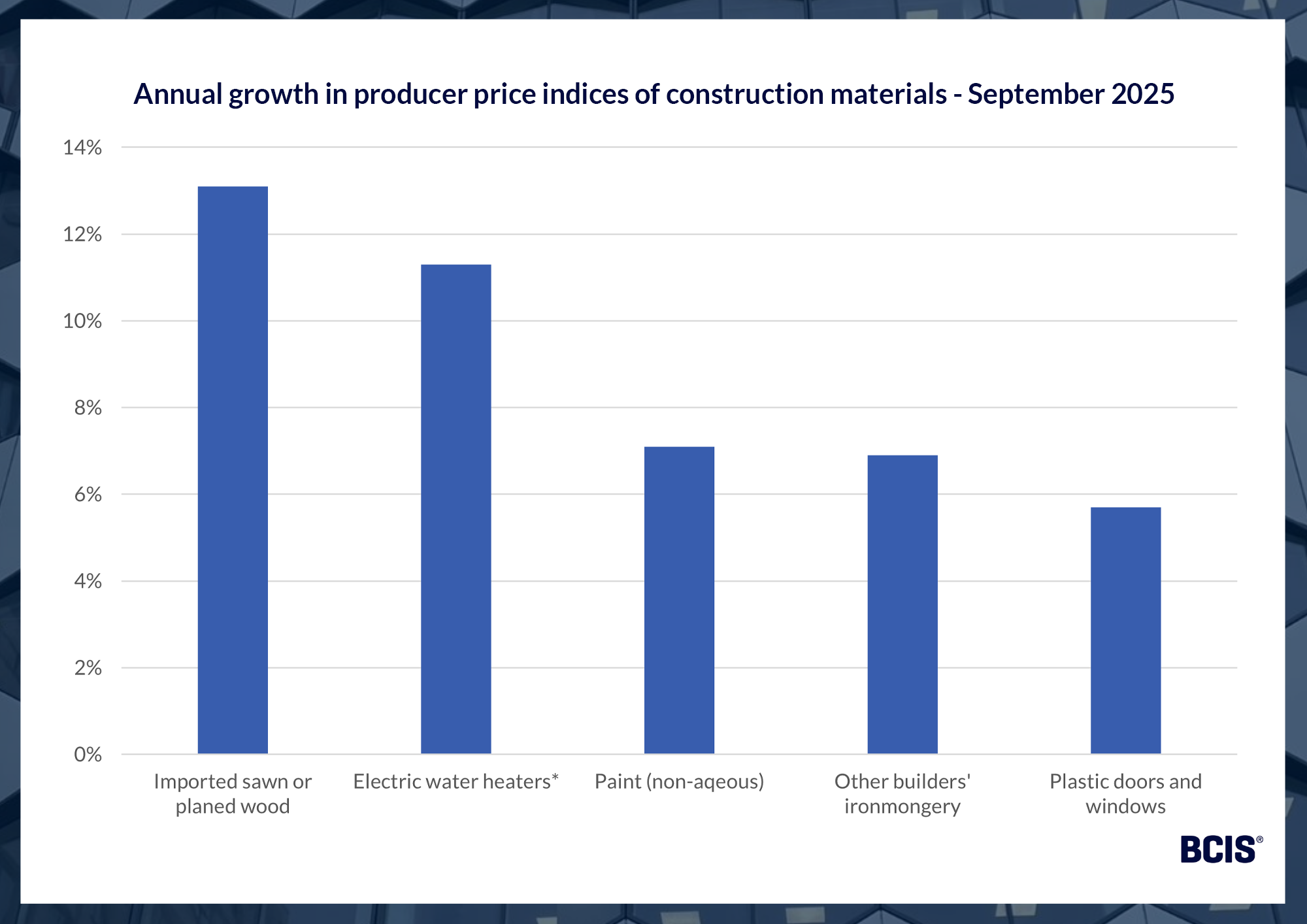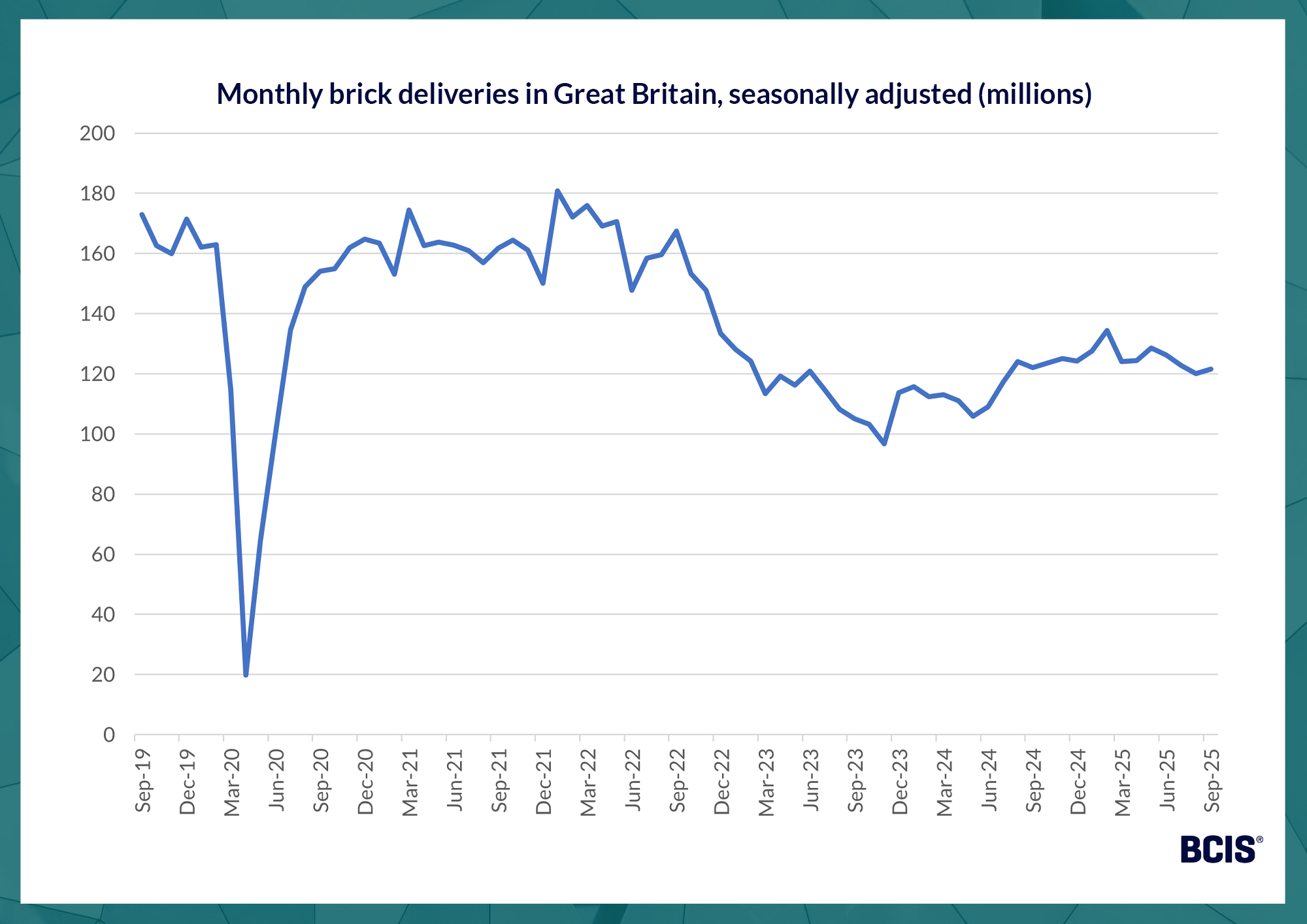BCIS CapX provides a comprehensive, detailed and easy-to-use method of measuring cost movement for building and civil engineering. Widely used in the construction and infrastructure sector to help fairly allocate risk between the client and sub-contractors.
Published: 06/11/2025
Each month the Department for Business and Trade (DBT) publishes construction material price indices, categorised under All Work, New Housing, Other New Work and Repair and Maintenance, as well as tracking a selection of building materials and components for the UK, and providing statistics on bricks and concrete blocks production, deliveries and stock for Great Britain(1).
Note: The Office for National Statistics (ONS) paused publication of its Producer Price Indices (PPIs) between March and October 2025, which in turn led to DBT pausing publication of new data in its Construction Material Price Indices (CMPIs).
BCIS data, which is used in the compilation of the DBT indices, has also been impacted by the ONS pause. Until publication of CMPIs resumes, BCIS is using internal PPI modelling to estimate provisional values.
As such, BCIS has published estimated figures for DBT Construction Material Price Indices: All Work, Housing, New Work, Repair and Maintenance for February to September 2025, which are available to subscribers.
Resumed Producer Price Indices show annual increases
Data on construction materials published by ONS for the first time since March show movement in producer price indices over recent months.
Imported sawn or planed wood prices rose by 13.1% between September 2024 and September 2025, while electric water heaters increased by 11.3%. Among the resources showing decreases on the year, imported plywood saw a 4.2% decline, while gravel, sand, clays and kaolin (exc Aggregate Levy) was down by 3.8%.
On the month, the most significant movement was in precast concrete blocks, bricks, tiles and flagstones, down 2.3%, while the Builders woodwork: doors and windows index increased by 1.3% between August 2025 and September 2025.
Source: Department for Business & Trade – Building materials and components statistics, Table 2
* DBT advises index values should not be relief upon for long-term contractual purposes, as they are based on relatively few quotes
Brick deliveries down on annual basis as stocks reach 15-month high
Brick deliveries (seasonally adjusted) decreased by 0.5% in the 12 months to September 2025 but were up 1.3% compared with the previous month.
Compared with pre-pandemic lockdown activity levels, seasonally adjusted brick deliveries in September 2025 were 29.7% lower than in September 2019.
Stocks of all types of bricks at the end of September stood at 499.2 million – the highest level recorded since June 2024. This was a 4.4% increase on brick stocks at the end of September 2024 (478.2 million) and a 27.4% rise on the level in September 2019 (391.7 million)
Source: Department for Business & Trade – Building materials and components statistics, Table 9a
DBT’s report also showed concrete block deliveries (seasonally adjusted) in Great Britain were down by 4.2% in the year to September 2025 and decreased by 3.5% on a monthly basis. They were down by 23.1% on September 2019.
Total stocks of concrete blocks stood at 6.4 million square metres’ worth at the end of September, an increase of 1.3% on September 2024.
What’s behind building materials production decline?
The DBT-published dataset, which covers back to 2012, showed both ready-mixed concrete deliveries and sand and gravel sales (seasonally adjusted) were at the lowest they have been, 2Q2020 except, in 2Q2025. Provisional data for 3Q2025 show a further drop for sand and gravel sales, 3% less than the previous quarter.
Further, the Mineral Products Association said domestic cement production has dropped to the lowest level since 1950, citing the impact of high energy costs and increased pressure from imports(2).
Dr David Crosthwaite, chief economist at BCIS, said: ‘Manufacturers of construction materials have to adjust their own output in line with demand, so there’s clearly an element of production responding to a cooler market. Brick deliveries, for example, remain well below pre-pandemic levels, while stocks are higher, suggesting that availability itself is not the primary issue.
‘One of the main challenges we’ve been hearing from our expert panels of consultants and contractors is not material shortages, but the lack of visibility about what is coming. Uncertainty around the project pipeline, combined with wider economic headwinds and planning delays, has led many clients to pause or slow schemes. That inevitably flows back through the supply chain and into production levels.
‘For government, a crucial form of support is to provide a clear, consistent pipeline of work. That visibility would give developers and funders the confidence to proceed and, in turn, manufacturers the confidence to align supply with the housing and infrastructure ambitions that have been set out. If demand strengthens and the flow of work becomes more predictable, production is likely to respond. That visibility could be just as important as tackling cost pressures in ensuring materials are available to meet future building needs.’
To keep up to date with the latest industry news and insights from BCIS, register for our newsletter here.


